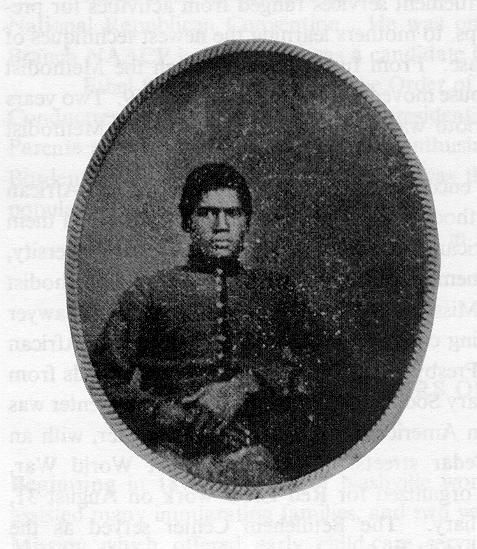 Black
Tennesseans were active participants in the American Civil War. They contributed
immeasurably to the Union victory. In 1860, Tennessee had 275,719 slaves,
who represented twenty-five percent of the population. Tennessee also had
7,300 free blacks in 1860, but they suffered racial discrimination and
second-class citizenship without the right to vote. The slaves were owned
by 36,894 persons, less than twenty percent of Tennessee's white families.
The majority non-slaveholding whites belonged to the yeoman class (farmers
and the poor, landless white class). Many white (i.e., East) Tennesseans
opposed slavery and wanted it stopped.
Black
Tennesseans were active participants in the American Civil War. They contributed
immeasurably to the Union victory. In 1860, Tennessee had 275,719 slaves,
who represented twenty-five percent of the population. Tennessee also had
7,300 free blacks in 1860, but they suffered racial discrimination and
second-class citizenship without the right to vote. The slaves were owned
by 36,894 persons, less than twenty percent of Tennessee's white families.
The majority non-slaveholding whites belonged to the yeoman class (farmers
and the poor, landless white class). Many white (i.e., East) Tennesseans
opposed slavery and wanted it stopped.
After the Civil War hostilities began at Fort Sumter, South Carolina (in April, 1861), Tennessee's radical Democrats, slaveowners, and southern nationalists led a campaign for secession. The voters defeated the first secession ordinance. But in May, 1861, emotions and pressure by the pro-Confederates ran high after Fort Sumter, causing the secession ordinance to pass. Still the Confederates were no more than a vocal minority because white Unionists (thirty-five percent) and blacks (twenty-six percent) outnumbered them. However, the Confederate minority used conscription acts, loyalty requirements, intimidation, racist propaganda, outright oppression, and occupation of East Tennessee to control most Tennessee inhabitants.
The illegal control of Tennessee by the minority Confederates was short-lived. They never had real support among the people in the countryside and could not command the state's resources to effectively prosecute the war. In great paradox, even the slaveowners generally refused to furnish slave labor for the Confederate army. The Confederate General Assembly passed a law to draft free blacks as military laborers in June of 1861.
However, a large Union army arrived in February of 1862, when General U. S. Grant's Union army easily defeated the Confederates at Fort Donelson. Nashville was surrendered quickly on February 23. Then the powerful Union army pushed the Confederates from Shiloh into Mississippi and occupied all Tennessee regions by late 1863. The state Confederate government and the secessionist leader, Governor Isham G. Harris, fled into exile.
The slaves no longer feared slave patrols, empty threats from the plantation mistresses, and movements of Confederate armies. By the fall of 1862, a flood of fugitive slaves caused the federal government to begin a contraband camp system at Grand Junction. Throughout Tennessee, tens of thousands of contraband camp dwellers became an essential labor force for the Union army. They helped to build huge forts, like Nashville's Fort Negley and Memphis' Fort Pickering. From Memphis to Nashville, to Chattanooga, to Knoxville, and even to Bristol, black men and women laborers repaired roads, bridges, and railroads, and served as teamsters, common laborers, military hospital workers, servants to officers, cooks, laundresses, cattle herders, assistant surgeons, blacksmiths, and military spies.
In the spring of 1863, the Union began to recruit and organize black soldiers. By war's end, some 20, 133 black Union army soldiers served in Tennessee within the following United States Colored Troops units: